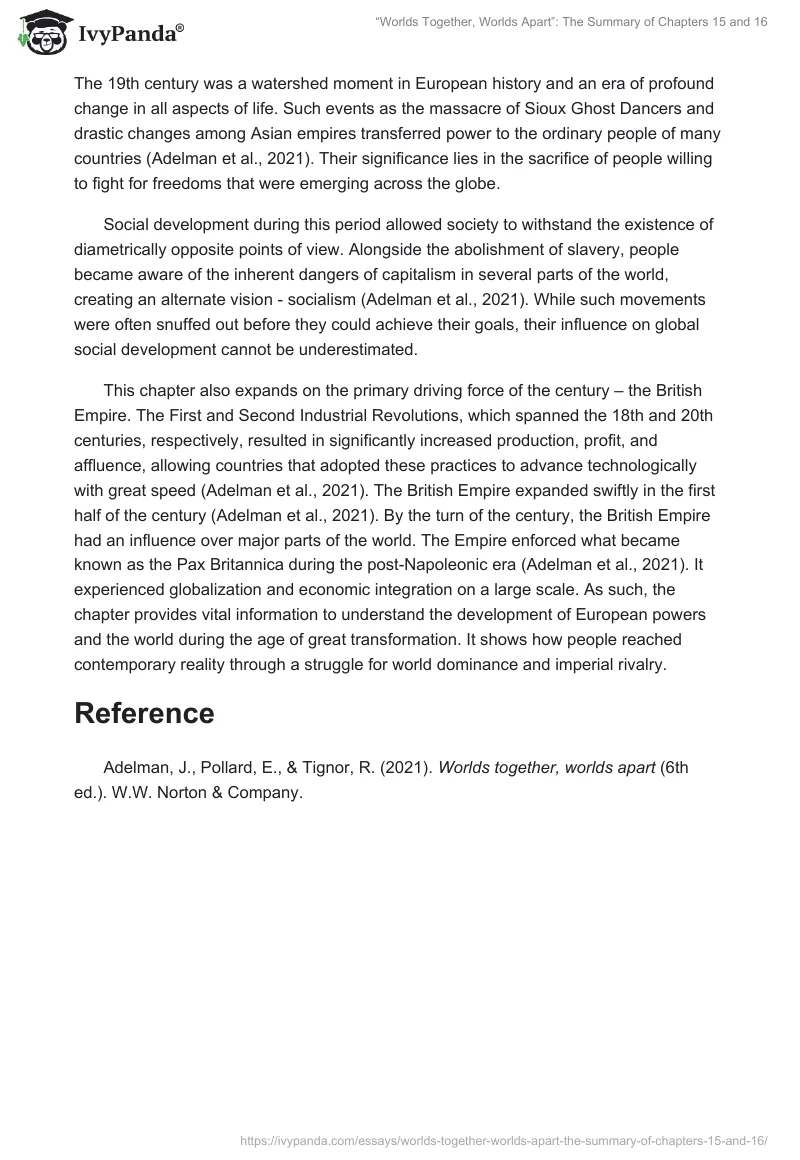Chapter 15 is about the emerging world between 1750 and 1850. The importance of this period is linked with new connections between countries from different continents. From the invasion of Napoleon Bonaparte to Egypt, Europeans began to set sights on foreign territories for both trade and conquer (Adelman et al., 2021). The occupation allowed Napoleon to reinforce the French Revolution ideals in new territories. Adelman et al. (2021) write that such actions “challenged.
Ottoman rule threatened the balance of power in Europe (p. 607). The described revolution destroyed colonialism and pushed elites into listening to people or being met with a threat of revolution (Adelman et al., 2021). Nonetheless, many countries flourished under these conditions and saw great positive changes in the societal foundation.
This chapter highlights the correlation between economic growth and major social restructures. The French Revolution that brought liberalism to Europe was a mark of a new era in which freedom started to play a critical role (Adelman et al., 2021). The major challenge for the world economy was political and social upheavals. Due to the changes in science, society, and politics that were driven by Enlightenment ideas, a significant transformation in Europe took place (Adelman et al., 2021). The information from the chapter is crucial as it shows that world politics and social order have changed due to the new ideas of liberty and nationhood. People across Europe started to struggle for their rights and demanded the independence of their nations. Several conflicts, including the North American War of Independence and the Revolution in Saint-Dominique, were led by oppressed populations that demanded freedom from foreign rulers on their territories (Adelman et al., 2021). The roots for democracy have taken hold and were spreading fast through countries and their colonies alike, ensuring eventual globalization through shared ideas and ideals.
Chapter 16 addresses the 19th century and events that changed the world order. It emphasizes protest movements against practices that were seen as detrimental to the world’s peace and prosperity, such as colonialism and inequality (Adelman et al., 2021). The 19th century was a watershed moment in European history and an era of profound change in all aspects of life. Such events as the massacre of Sioux Ghost Dancers and drastic changes among Asian empires transferred power to the ordinary people of many countries (Adelman et al., 2021). Their significance lies in the sacrifice of people willing to fight for freedoms that were emerging across the globe.
Social development during this period allowed society to withstand the existence of diametrically opposite points of view. Alongside the abolishment of slavery, people became aware of the inherent dangers of capitalism in several parts of the world, creating an alternate vision – socialism (Adelman et al., 2021). While such movements were often snuffed out before they could achieve their goals, their influence on global social development cannot be underestimated.
This chapter also expands on the primary driving force of the century – the British Empire. The First and Second Industrial Revolutions, which spanned the 18th and 20th centuries, respectively, resulted in significantly increased production, profit, and affluence, allowing countries that adopted these practices to advance technologically with great speed (Adelman et al., 2021). The British Empire expanded swiftly in the first half of the century (Adelman et al., 2021). By the turn of the century, the British Empire had an influence over major parts of the world. The Empire enforced what became known as the Pax Britannica during the post-Napoleonic era (Adelman et al., 2021). It experienced globalization and economic integration on a large scale. As such, the chapter provides vital information to understand the development of European powers and the world during the age of great transformation. It shows how people reached contemporary reality through a struggle for world dominance and imperial rivalry.
Reference
Adelman, J., Pollard, E., & Tignor, R. (2021). Worlds together, worlds apart (6th ed.). W.W. Norton & Company.


